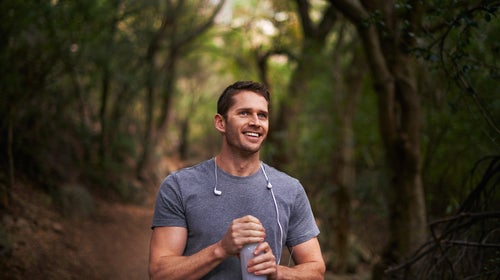If you picked up running as a way to lose weight, the idea of eating while exercising may seem counterintuitive. ArenÔÇÖt I supposed to be burning calories, not consuming them?
HereÔÇÖs a quick explainer: Your body can store only┬áa limited amount of carbohydrates. ÔÇťAdding consistent fuel intake from carbohydrates, electrolytes, and fluids during long workouts will help maintain blood glucose concentrations,ÔÇŁ says Marni Sumbal, a┬átriathlon coach, elite triathlete,┬áand board-certified sports dietitian.┬á
Water is all you need if youÔÇÖre pounding the pavement for an hour or less. Longer than┬áthat, ÔÇťaim for 30 to┬á60 grams of glucose per hour,ÔÇŁ says Sumbal. She has most of her athletes do this by sipping an electrolyte-enhanced sports drink. In her opinion, taking in pure glucose is best, because itÔÇÖs absorbed directly from the stomach into the bloodstream.┬áSumbal┬áthinks most athletes should be using prepacked energy foods for runs. ÔÇťCompanies are doing this for you, and IÔÇÖd rather you spend that time out training than in the kitchen playing chemist.ÔÇŁ
However, athletes are increasingly asking for real food options, which is why companies like Clif Bar are responding with baby-food-like packets of pureed banana and mango.  
You will never go wrong with gel packets from the major energy food companies. They are tried-and-true options that many racers come back to year after year. But if you want something that seems less like a relic from a past space mission and more like, you know, food, try one of these 10 great options. 
Honey
A ┬áat the University of Memphis found that honey mixed with a touch of water fueled┬áexercise just as effectively┬áas commercial sports gels. Honey , which may help reduce oxidative stress, a by-product of extreme exercise. However, different types of honey have . For the best bang for your buck, try buckwheat honey mixed with water in a small reusable flask. Each tablespoon of honey contains┬á15┬áto┬á18┬ágrams of carbohydrates, so a few tablespoons should supply an average athlete with an hourÔÇÖs worth of fuel. If youÔÇÖre wary of making your own slurry, sells a 95┬ápercent real-honey gel in single-serving packets.┬á
Maple Syrup
Like honey, maple syrup is considered to be a lower┬áglycemic index food than pure cane sugar. This means it will have less of a ÔÇťpanic┬áat┬áthe┬ástock┬ámarketÔÇŁ effect on your blood sugar levels. If youÔÇÖre prone to the dizzying effects of spikes and crashes, choosing either maple syrup or honey might make you feel more in control. Plus, maple syrup is high in minerals like calcium, manganese and potassium. Like honey, it has about 15 grams of carbs per tablespoon. , a company founded by former pro cyclist Ted King, offers premeasured pouches of pure maple syrup.┬á
Sweet Potatoes
ÔÇťEating while running takes practice,ÔÇŁ says Tommy Rodgers, a North CarolinaÔÇôbased coach and registered dietician. If you can master itÔÇöand your GI tract can handle digesting through all that bouncingÔÇöit opens up a whole new world of possibilities. Solid foods like sweet potatoes are your best during long, slow efforts┬álike ultras. Research has shown that the lower the intensity at which youÔÇÖre running, the more likely youÔÇÖll be able to process solids. But thatÔÇÖs ideal, because long efforts are where youÔÇÖre most likely to suffer from flavor fatigueÔÇöthat feeling you get when youÔÇÖve been downing nothing but lemon-lime sports drink all day and canÔÇÖt even bear to take one more sip. In moments like this, having a wrapped-up sweet potato,┬áwith its , is a godsend. Like anything, ÔÇťalways try foods in training before race day,ÔÇŁ says Rodgers,┬áespecially if youÔÇÖve never consumed anything but gel on the run. If carrying a wrapped potato in your pocket isnÔÇÖt your idea of a good time, pro cyclist Ally Stacher uses sweet potatoes as the base for her .
Pickle Juice
Believe it or not, the science of what causes muscle cramps is far from settled, but researchers have found that one thing that reliably relieves muscle cramps is pickle juice. Interestingly, on the topic, itÔÇÖs not because of the sodium in the brine. In one study, pickle juice relieved the cramp too quickly for the stomach to have absorbed┬áthe sodium or water in the brine. Researchers think the effect may have more to do with our brain sensing the taste of the brine, versus a true chemical change. The important thing is that it works. ┬á┬á
Chia Seeds
In the 2009 book , author Chris McDougall┬árefers to these tiny seeds as the original superfood for ultrarunners. TheyÔÇÖre essentially flavorless┬ábut full of omega-3s, dietary fiber, and niacin, which ┬á(the good kind!). Throw a tablespoon or two into your water bottleÔÇöyou likely wonÔÇÖt even notice them. (Although they can get a bit gelatinous after a while,┬áso practice before race day.)┬áIf you want your chia seeds worked into a premade gel, has you covered. ┬á
Bananas
A staple at marathon aid stations since the dawn of the mass-start race, bananas are beloved for their high levels of potassium and minimal-chewing-needed texture. Unfortunately, they arenÔÇÖt terribly portable since they bruise easilyÔÇöbut thatÔÇÖs where baby food companies come in handy. Look for a pure banana puree, or opt for a product from a company like , which blends banana with beets and ginger in an easy-to-eat-from pouch.┬á
Homemade Energy Drink
There is nothing wrong with consuming a ready-mixed sports drink. Having the electrolyte formula worked out by a true sports nutritionist is as foolproof as it gets. But if you want to do something from scratch, Elyse Kopecky, co-author of and a former NCAA runner, recommends a blend of coconut water, pure orange juice, honey, and sea salt. The coconut water provides potassium, the orange juice and honey deliver flavor and carbohydrates, and the salt keeps your sodium levels steady as you sweat. 
Raisins
Rodgers suggests these to his athletes who want a real food option instead of energy chews or sport beans. Raisins have potassium, iron, and some calcium, along with about 30 grams of carbohydrates per serving. Best of all, theyÔÇÖre small enough that if you accidentally swallow one while running (it happens!), itÔÇÖs wonÔÇÖt cause a major coughing fit.┬á


